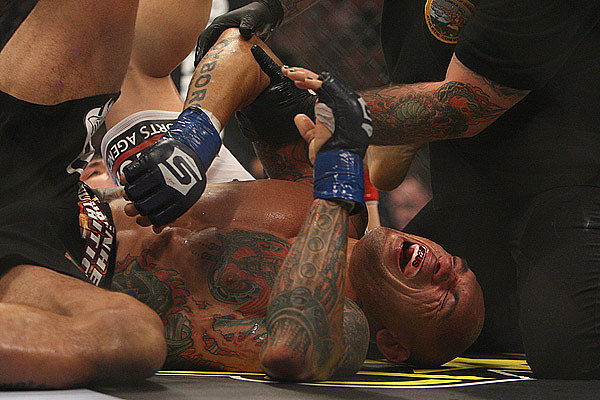Fistic Medicine: Mechanics of the Armbar
Matt Pitt Apr 15, 2011

The well-executed armbar is like the well-executed checkmate: a position in which no harm is experienced but from which escape is impossible. Executing this -- gaining total advantage over an opponent -- involves a little more in MMA.
The effective, inescapable armbar -- whether in sambo, MMA, judo or jiu-jitsu -- requires the simultaneous achievement of muscle and mechanical advantage to lock the elbow at, or push it past, its maximum physiologic extension.
Advertisement
Of these three arm flexors, it is the biceps brachii, with points of origin on the scapula and insertion on the proximal radius and ulna, that is the strongest and has the greatest mechanical advantage. Unfortunately for the defender, the effective strength of the biceps, which supinates the forearm as well as flexing the elbow, can be substantially decreased by putting the hand in full pronation. The desired “thumbs up” position for submitting a fighter via armbar achieves this by rotating the hand and forearm internally as far as possible. This is part of the importance of wrist control in grappling; once the arm is isolated and pronated, efforts to defend the armbar give way to efforts to escape.
To maximize the joint extension he can inflict, an attacker needs
optimum body geometry with his opponent. The tip of the defender’s
elbow, the olecranon, should be on the attacker’s pubic symphysis,
the most anterior portion of the pelvis. With the fulcrum of the
arm on his pubic symphisis, or less optimally the hip, an attacker
thrusts upwards, arching his back while extending at the hips. The
combined physiologic extension of hips and spine is 55 degrees; the
total extension the elbow can endure without sustaining damage is
3-5 degrees.
Simultaneously, the attacker uses his legs to immobilize the arm he has taken and keeps the defender’s chest pinned sternum up and flat. This position limits lateral movement of the joint and prevents the defender from relieving stress on the elbow by lifting or rotating his shoulder.
The last component of a well-executed armbar is immediate extension of the opponent’s arm. Rapid full extension denies the defender the chance to recover his lost limb and renders the flexor muscles impotent. With the elbow angle at zero degrees -- its maximum extension -- the muscle tendons inserting on the proximal radius and ulna are mechanically disadvantaged. Any weightlifter knows this intuitively; a curl bar that cannot be flexed from full extension can be lifted if it’s first sloppily swung up a few degrees. This mechanical disadvantage is exacerbated if the attacker is holding the arm high, at the hand and wrist, using the full leverage of the forearm to break the joint. Done correctly, the armbar is as sudden as a snake strike and definitive as a bullet between the eyes.
Implicit in the locked-in armbar is the threat of imminent harm. A defender faces not only the risk of a loss on his record but -- if he does not tapout or if the referee fails to save him -- a crippling injury. A 1998 study looked at the injuries sustained by an elbow hyperextension. Experimenters took severed cadaver arms, fixed the humerus in place and then subjected repeated downward force to the outstretched hand. Skin and soft tissue were removed to expose the bone and ligament of the joint. As increasing force was applied, the elbow bent backwards. The anterior capsule -- a broad band of connective tissue connecting the distal humerus to the proximal radius and ulna -- ruptured first. Then the origin of the pronator muscle tore, the lateral collateral ligament ruptured and cartilage of the ulna tore. These injuries result in permanent laxity of the joint.
With greater force -- about 200 to 400 pounds, easily within the ability of fighters -- dislocation of the joint and tendon rupture occur. These injuries can only be partially repaired. If the tendon is stronger than the bone to which it is attached -- as often happens in athletes -- the bone can buckle and break.
A pair of case studies is illuminating. In his fight against Dan Hardy at UFC 111, Georges St. Pierre was clearly the superior grappler. His dominant ground work led to multiple armbar attempts against Hardy. All failed. Looking at the video, we see Hardy’s elbow was routinely high on St. Pierre’s abdomen; St. Pierre’s legs were spread, allowing Hardy to writhe out of danger. In comparison, Nick Diaz’s fight against Evangelista “Cyborg” Santos hit the ground once. Twenty-one seconds later, Diaz had bracketed Santos’ shoulder with his legs, isolated an arm and grasped two hands around his opponent’s fully pronated wrist. Two seconds after that, Diaz’s back was arched, Santos’ arm was hyperextended to at least 10 degrees and referee Josh Rosenthal was leaping in to end the fight.
The question of whether Diaz is a better fighter than St. Pierre is debatable, but the quality of his armbar is not.
Matt Pitt is a physician with degrees in biophysics and medicine. He is board-certified in emergency medicine and has post-graduate training in head injuries and multi-system trauma. To ask a question that could be answered in a future article, e-mail him at [email protected].







